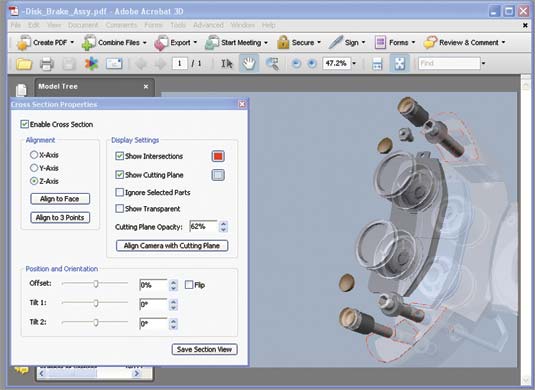Once upon a time the CAD world waited with breathless anticipation for the second release of Acrobat with 3D capabilities. Four years later, we are still waiting for the promise to be achieved. Here, from the archives of Engineering Automation Report, is the origin story of a wannabe superhero; no foreshadowing added.
By Randall S. Newton
Engineering Automation Report, April 2007—Adobe will soon start shipping Acrobat 3D Version 8, a superset of Acrobat Professional. The new release is a game-changer in its ability to import and export 3D CAD data in a variety of formats.
In language that sometimes moves from promotion to warning, Adobe claims the use of the PRC format (acquired when it bought TTF in 2006) allows Adobe PDF be a conduit for precise and highly compressed 3D geometry with topology. The PDF can also include Product Manufacturing Information (PMI), used to convey information such as geometric dimensioning and tolerancing, annotations, and other specifications, directly on the 3D model. This makes 3D PDF suitable for what it calls the downstream use of CAD data, for tool and mold design, CNC milling, and analysis.

To place a model in Acrobat 3D the user must first decide on the level of precision to be shared. Will the model be viewed or queried? It boils down to a choice between geometry and tessellation. Sending geometry gives anyone who receives the PDF access to CAD data; tessellation is the “look but don?t touch” option. Once a 3D model is placed into a 3D PDF using the PRC format, it can later be exported as a STEP or IGES file.
Adobe does not want users to think of Acrobat 3D as a CAD-to-CAD file conversion utility, but the capabilities are there nonetheless. CAD managers need to think though how they will administer 3D PDF files before they are faced with a library of PDF?s saved in every possible way, because using either the new PRC format or the existing U3D format, users can choose:
PRC B-rep (Solid)—Includes the 3D model?s geometry information. File size is the smallest, but polygonal representation is generated each time the file is opened.
PRC B-rep + Tessellation—Includes the 3D model?s geometry information and polygon settings. If no polygon settings are present, Acrobat 3D Version 8 generates them on conversion to PDF. The resulting files are slightly larger, but open faster due to the polygons already having been created.
PRC Tessellation (Faceted)—Retains or generates new polygon settings. For situations where only file viewing is required, but speed and size are important.
U3D ECMA 3—Compatible with Acrobat 8 and Adobe Reader 8, Adobe says this option produces file sizes up to three times smaller than the previous U3D implementation.
U3D ECMA 1—Compatible with Acrobat 3D and Adobe Reader 7.07 or higher.
Collaboration and Interoperability?
Adobe says there is a three-fold value proposition for Acrobat 3D. One, users can save time by using 3D designs for collaboration, without dumbing down to 2D. Two, users can repurpose 3D assets for richer technical documentation. Three, interoperability can be improved. “We intend to do the best STEP,” one Adobe representative told me.
We take points one and two as no-brainers, given Adobe?s history and how PDF has become the de facto digital publishing standard. But point three makes Acrobat 3D the new interoperability sheriff in town; we expect other vendors will have something to say about that.
Rak Bhalla, Senior Marketing Manager for the Knowledge Worker Business Unit at Adobe, suggests the following scenario as typical for how Acrobat 3D offers a new interoperability alternative. A MasterCAD user is sent a CATIA V5 file. To use it, there are three options, from most expensive to least expensive:
- Buy a CATIA license, open the file and convert it to STEP;
- Buy a CAD translator, and convert the file;
- Buy Adobe Acrobat 3D Version 8. Import the CATIA file to 3D PDF, then export the CAD data to STEP from the PDF.
Bhalla qualifies what Adobe means by interoperability. “We want to enable the downstream use of the CAD data.” The Adobe intention isn?t to be a tool for CAD-to-CAD file sharing, complete with feature history, but only to “make data available downstream where all [the user] needs is the model.” Thus Acrobat 3D becomes the manufacturing equivalent of a Swiss Army Knife; one tool, many possibilities.
Supported CAD formats
Adobe Acrobat 3D Version 8 supports the following formats:
• ACIS, up to version 13.0
• Autodesk Inventor, up to 10
• CATIA V4, up to 4.2.4
• CATIA V5, up to R16
• CGR
• IGES, up to 5.3
• JT, up to 8.0
• Parasolid, up to 16.0
• Pro/ENGINEER, up to Wildfire III
• SolidWorks, up to 2006
• STEP, AP 203, AP 214
• STL
• I-DEAS, up to 12.x
• NX (Unigraphics), up to NX4
• VRML, up to 2.0
• XVL, P-XVL
In use, Acrobat 3D is surprisingly quick. Models can be rotated at will without the sluggishness that haunted previous versions. It doesn’t take long to learn how to show and hide the model tree, to hide specific parts or layers, to create cross sections, to measure in the model, or to access PMI if available. Adobe claims using the PRC format gives them a compression ratio of up to 150x when compared to the original file.
Adobe has released a free public “preview release” of Adobe Acrobat 3D Version 8. Like an offering from a CAD developer?s “labs” site, the product will have full functionality, although only for a limited time. After a chance for final feedback and fixes, Adobe will release the final product sometime during the second quarter of the year. The retail price will continue to be $995. The product will initially ship in English, International English, French, German, and Japanese initially.





